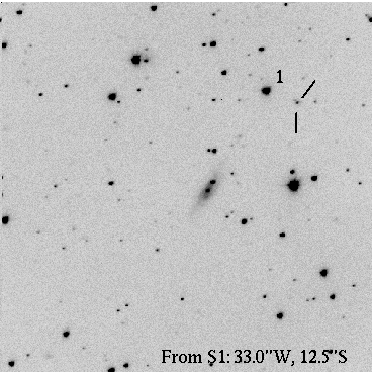

Circular No. 8006
Central Bureau for Astronomical Telegrams INTERNATIONAL ASTRONOMICAL UNION Mailstop 18, Smithsonian Astrophysical Observatory, Cambridge, MA 02138, U.S.A. IAUSUBS@CFA.HARVARD.EDU or FAX 617-495-7231 (subscriptions) BMARSDEN@CFA.HARVARD.EDU or DGREEN@CFA.HARVARD.EDU (science) URL http://cfa-www.harvard.edu/iau/cbat.html Phone 617-495-7244/7440/7444 (for emergency use only)
SUPERNOVA 2002hi W. Li, University of California at Berkeley (UCB), reports the discovery by LOTOSS (cf. IAUC 7906) of an apparent supernova (mag about 17.9) on unfiltered KAIT images taken on Oct. 21.5 and 31.5 UT. SN 2002hi is located at R.A. = 7h19m54s.08, Decl. = +17o58'18".2 (equinox 2000.0), which is within 1".0 of the nucleus of a diffuse faint galaxy. A KAIT image taken on Mar. 30.2 UT showed nothing at this position (limiting mag about 19.0). R. Chornock, S. Jha, and A. V. Filippenko, UCB; and B. Barris, University of Hawaii, write that a spectrum (range 400-1000 nm), obtained on Nov. 1.6 UT with the Keck II 10-m telescope (+ ESI), shows that SN 2002hi is a type-IIn supernova, with strong H-alpha emission having very broad (FWHM about 13000 km/s) and intermediate-width (FWHM about 2000 km/s) components. The very broad component is also visible in the He I 587.6-nm emission line. Intermediate-width emission similar to that of Wolf-Rayet stars is present at a rest wavelength of about 465 nm, unusual even among type-IIn supernovae. Aside from the Wolf-Rayet lines, the spectrum is similar to that of SN 1988Z at early times (Filippenko 1997, ARAA 35, 309, and references therein). Accordingly, the object might become quite luminous at radio and x-ray wavelengths, because of interaction of the ejecta with dense circumstellar gas. The host-galaxy redshift derived from narrow [N II] 658.3-nm emission is 0.061.
-----------------------------
Host galaxy info: z=0.061
SN type info: IIn
------------------------------
Return to KAIT home page